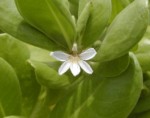Scientific Name: Scaevola gaudichaudiana; S. gaudichaudii; S. mollis
Indigenous
Description: A large shrub with large, green, thick leaves, soft white fruit and the well known “half flower.”
Distribution: This native Hawaiian species is found throughout the tropics on the coast. Locally, naupaka can be found on practically every sandy or rocky beach.
Landscape Uses and Care: Naupaka kahakai makes a great hedge. Its natural habitat will tell you that this plant thrives in full sun and needs very little water once established in the ground. This plant can be shaped into a low hedge or groomed into a large hedge reaching over 10 feet tall. Planting them every 2 feet will ensure a thick and beautiful hedge. Very few pests bother this extremely hardy plant.
Additional Information: On sandy beaches, the wind-breaking effect of naupaka traps sand at their roots, forming a mound. Over periods of time, the continuing sand deposits turn into sand dunes.
This can easily be seen at places like Allen Davis or A.D.’s, formerly known as Queen’s Beach.
Today, places like this (A.D.’s, Ka’ena point, Kahuku, etc.) are being threatened by the use of off-road vehicles. These places harbor many endangered plant species that off-roaders may not realize are being harmed.
Many of the coastlines that once were home to numerous sand dunes are now covered with ironwood trees that don’t encourage the formation of dunes. Instead, these plants that are planted as windbreaks invasively spread, preventing anything from growing under them.
Let’s keep the rest of our beaches from being taken over by invasive alien plants such as ironwood and plant more naupaka instead. They look better and also serve as windbreaks, without hurting other plantlife or our feet. Ever step on the ironwood seed cones?
Naupaka kahakai







